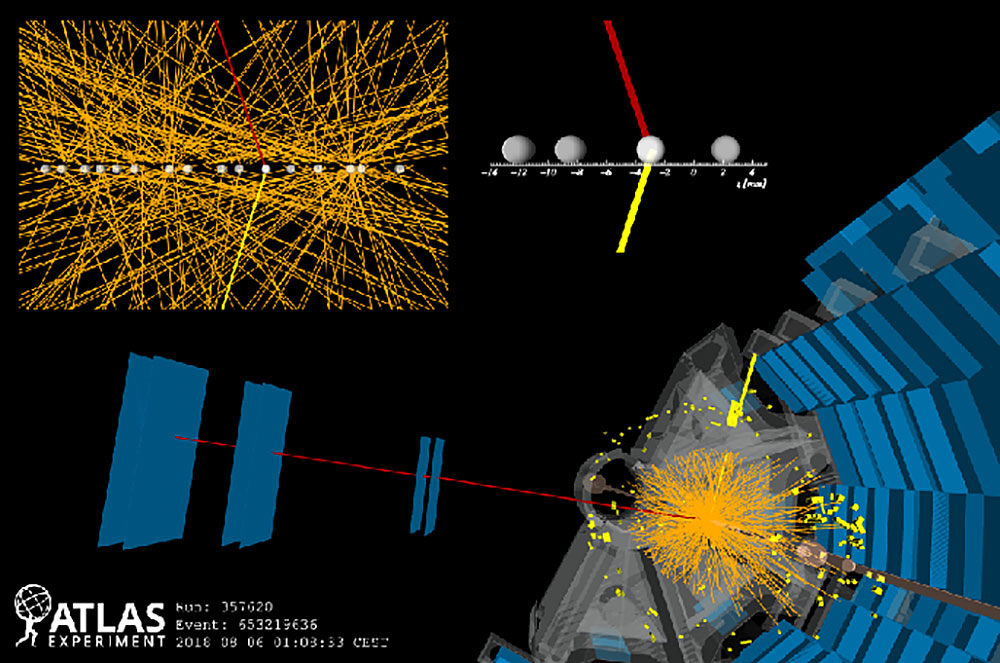Rare Phenomenon Observed by ATLAS Features the LHC as a High-energy Photon Collider
ATLAS experiment reports the observation of photon collisions producing weak-force carriers and provides further insights into their interactions.
August 5, 2020

A 2018 ATLAS event display consistent with the production of a pair of W bosons from two photons, and the subsequent decay of the W bosons into a muon and an electron (visible in the detector) and neutrinos (not detected). (Credit: CERN)
The following media update about new research results from the Large Hadron Collider (LHC) was originally posted by CERN, the European particle physics laboratory. The U.S. Department of Energy's Brookhaven National Laboratory serves as the U.S. host laboratory for the ATLAS experiment at the LHC and plays multiple roles in this international collaboration, from construction and project management to data storage, distribution, and analysis. Brookhaven Lab scientists have been leading the studies that use the LHC as a source of photons, including the analysis that led to the first light-by-light scattering result and additional results presented at the ICHEP 2020 conference. Brookhaven scientists are also carrying out complementary studies of W boson pairs produced at the LHC via the interactions of quarks and gluons, the interaction of W bosons, and from the decay of the Higgs boson. These studies provide different ways of tackling the same quest for a deeper understanding of the electromagnetic and weak interactions. For more information about Brookhaven's role in research at ATLAS, see: http://www.bnl.gov/atlas/. To interview a Brookhaven Lab scientist about these new results, contact Karen McNulty Walsh, kmcnulty@bnl.gov, 631 344-8350.
During the International Conference on High-Energy Physics (ICHEP 2020), the ATLAS Collaboration presented the first observation of photon collisions producing pairs of W bosons, elementary particles that carry the weak force, one of the four fundamental forces. The result demonstrates a new way of using the LHC, namely as a high-energy photon collider directly probing electroweak interactions. It confirms one of the main predictions of electroweak theory—that force carriers can interact with themselves—and provides new ways to probe it.
According to the laws of classical electrodynamics, two intersecting light beams would not deflect, absorb or disrupt one another. However, effects of quantum electrodynamics (QED), the theory which explains how light and matter interact, allow interactions among photons.
Indeed, it is not the first time that photons interacting at high energies are studied at the LHC. For instance, the light-by-light “scattering”, where a pair of photons interact by producing another pair of photons, is one of the oldest predictions of QED. The first direct evidence of light-by-light scattering was reported by ATLAS in 2017, exploiting the strong electromagnetic fields surrounding lead ions in high-energy lead-lead collisions. In 2019 and 2020, ATLAS further studied this process by measuring its properties.
The new result reported at this conference is sensitive to another rare phenomenon in which two photons interact to produce two W bosons of opposite electric charge via (among others) the interaction of four force carriers. Quasi-real photons from the proton beams scatter off one another to produce a pair of W bosons. A first study of this phenomenon was previously reported by ATLAS and CMS in 2016, from data recorded during the LHC Run 1, but a larger dataset was required to unambiguously observe it.
The observation was obtained with a highly significant statistical evidence of 8.4 standard deviations, corresponding to a negligible chance of being due to a statistical fluctuation. ATLAS physicists used a considerably larger dataset taken during Run 2, the four-year data collection in the LHC which ended in 2018, and developed a customised analysis method.
Owing to the nature of the interaction process, the only particle tracks visible in the central detector are the decay products of the two W bosons, an electron and a muon with opposite electric charge. W-boson pairs can also be directly produced from interactions between quarks and gluons in the colliding protons considerably more often than from photon-photon interactions, but these are accompanied by additional tracks from strong interaction processes. This means that the ATLAS physicists had to carefully disentangle collision tracks to observe this rare phenomenon.
“This observation opens up a new facet of experimental exploration at the LHC using photons in the initial state”, said Karl Jakobs, Spokesperson of the ATLAS Collaboration. “It is unique as it only involves couplings among electroweak force carriers in the strong-interaction dominated environment of the LHC. With larger future datasets it can be used to probe in a clean way the electroweak gauge structure and possible contributions of new physics.”
Indeed, the new result confirms one of the main predictions of electroweak theory that, besides interacting with ordinary particles of matter, the force-carriers, also known as gauge bosons—the W bosons, the Z boson and the photon—are also interacting with each other. Photon collisions will provide a new way to test the Standard Model and to probe for new physics, necessary for a better understanding of our Universe.
Brookhaven Lab’s contributions to ATLAS are funded by the U.S. Department of Energy’s Office of Science.
Brookhaven National Laboratory is supported by the Office of Science of the U.S. Department of Energy. The Office of Science is the single largest supporter of basic research in the physical sciences in the United States and is working to address some of the most pressing challenges of our time. For more information, please visit science.energy.gov. Follow @BrookhavenLab on Twitter or find us on Facebook.
2020-17364 | INT/EXT | Newsroom









